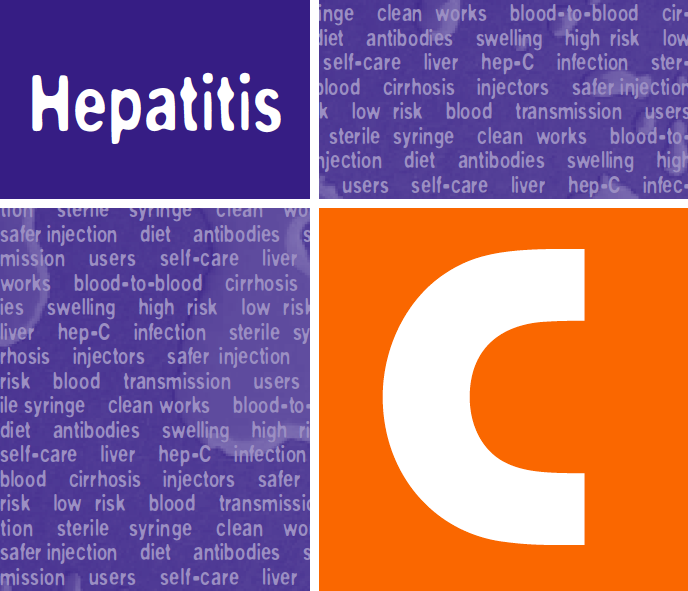 Hepatitis C is a contagious liver disease that results from infection with the Hepatitis C virus. It can range in severity from a mild illness lasting a few weeks to a serious, lifelong illness. Hepatitis C is usually spread when blood from a person infected with the Hepatitis C virus enters the body of someone who is not infected. Today, most people become infected with the Hepatitis C virus by sharing needles or other equipment to inject drugs. Before 1992, when widespread screening of the blood supply began in the United States, Hepatitis C was also commonly spread through blood transfusions and organ transplants.Hepatitis C can be either “acute” or “chronic.” Acute Hepatitis C virus infection is a short-term illness that occurs within the first 6 months after someone is exposed to the Hepatitis C virus. For most people, acute infection leads to chronic infection. Chronic Hepatitis C is a serious disease than can result in long-term health problems, or even death.There is no vaccine for Hepatitis C. The best way to prevent Hepatitis C is by avoiding behaviors that can spread the disease, especially injection drug use.
Hepatitis C is a contagious liver disease that results from infection with the Hepatitis C virus. It can range in severity from a mild illness lasting a few weeks to a serious, lifelong illness. Hepatitis C is usually spread when blood from a person infected with the Hepatitis C virus enters the body of someone who is not infected. Today, most people become infected with the Hepatitis C virus by sharing needles or other equipment to inject drugs. Before 1992, when widespread screening of the blood supply began in the United States, Hepatitis C was also commonly spread through blood transfusions and organ transplants.Hepatitis C can be either “acute” or “chronic.” Acute Hepatitis C virus infection is a short-term illness that occurs within the first 6 months after someone is exposed to the Hepatitis C virus. For most people, acute infection leads to chronic infection. Chronic Hepatitis C is a serious disease than can result in long-term health problems, or even death.There is no vaccine for Hepatitis C. The best way to prevent Hepatitis C is by avoiding behaviors that can spread the disease, especially injection drug use.
Category: Safety at Home
MRSA and the Workplace
 Staphylococcus aureus, often referred to simply as “staph,” is a type of bacteria commonly carried on the skin or in the nose of healthy people. Sometimes, staph can cause an infection. Staph bacteria are one of the most common causes of skin infections in the United States. Most of these skin infections are minor such as pustules and boils and can be treated without antibiotics. However, staph bacteria also can cause serious infections such as surgical wound infections, bloodstream infections, and pneumonia.
Staphylococcus aureus, often referred to simply as “staph,” is a type of bacteria commonly carried on the skin or in the nose of healthy people. Sometimes, staph can cause an infection. Staph bacteria are one of the most common causes of skin infections in the United States. Most of these skin infections are minor such as pustules and boils and can be treated without antibiotics. However, staph bacteria also can cause serious infections such as surgical wound infections, bloodstream infections, and pneumonia.
via CDC – MRSA and the Workplace – NIOSH Workplace Safety and Health Topic.
Avoid Exposure to Bloodborne Infectious Diseases
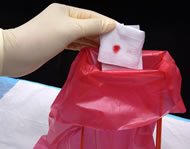 Exposures to blood and other body fluids occur across a wide variety of occupations. Health care workers, emergency response and public safety personnel, and other workers can be exposed to blood through needlestick and other sharps injuries, mucous membrane, and skin exposures. The pathogens of primary concern are the human immunodeficiency virus HIV, hepatitis B virus HBV, and hepatitis C virus HCV. Workers and employers are urged to take advantage of available engineering controls and work practices to prevent exposure to blood and other body fluids.
Exposures to blood and other body fluids occur across a wide variety of occupations. Health care workers, emergency response and public safety personnel, and other workers can be exposed to blood through needlestick and other sharps injuries, mucous membrane, and skin exposures. The pathogens of primary concern are the human immunodeficiency virus HIV, hepatitis B virus HBV, and hepatitis C virus HCV. Workers and employers are urged to take advantage of available engineering controls and work practices to prevent exposure to blood and other body fluids.
What is COPD?
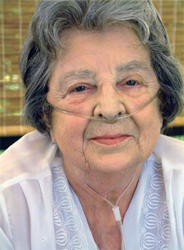 Chronic obstructive pulmonary disease COPD refers to a group of lung diseases that block airflow as you exhale and make it increasingly difficult for you to breathe. Emphysema and chronic asthmatic bronchitis are the two main conditions that make up COPD. In all cases, damage to your airways eventually interferes with the exchange of oxygen and carbon dioxide in your lungs. COPD is a leading cause of death and illness worldwide. Most COPD is caused by long-term smoking and can be prevented by not smoking or quitting soon after you start. This damage to your lungs can’t be reversed, so treatment focuses on controlling symptoms and minimizing further damage.
Chronic obstructive pulmonary disease COPD refers to a group of lung diseases that block airflow as you exhale and make it increasingly difficult for you to breathe. Emphysema and chronic asthmatic bronchitis are the two main conditions that make up COPD. In all cases, damage to your airways eventually interferes with the exchange of oxygen and carbon dioxide in your lungs. COPD is a leading cause of death and illness worldwide. Most COPD is caused by long-term smoking and can be prevented by not smoking or quitting soon after you start. This damage to your lungs can’t be reversed, so treatment focuses on controlling symptoms and minimizing further damage.
Strangulation Hazard – Baby Monitor Cords
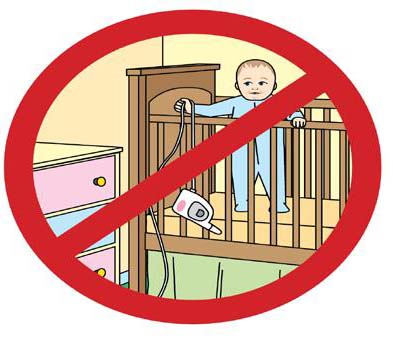 Cords from baby audio and video monitors present a strangulation hazard to young children if the monitors are placed within reach. Parents should take the following precautions to help prevent strangulation:
Cords from baby audio and video monitors present a strangulation hazard to young children if the monitors are placed within reach. Parents should take the following precautions to help prevent strangulation:
- Check the location of all monitors and products with electrical cords.
- Make sure potentially hazardous products with cords are not within reach of children.
- Keep monitors at least 3 feet from any part of cribs or beds.
Since 2002, seven children have died due to entanglement in a baby monitor cord and three children have nearly been strangled. The victims were between 6 and 20 months old, according to a press release from JPMA.
Lightning Can be Deadly
 Summer is the peak season for one of the nations deadliest weather phenomena— lightning. But don’t be fooled, lightning strikes year round. In the United States, an average of 54 people are reported killed each year by lightning. To date, there have been 16 deaths in 2012. Hundreds of people are permanently injured each year. People struck by lightning suffer from a variety of long-term, debilitating symptoms, including memory loss, attention deficits, sleep disorders, chronic pain, numbness, dizziness, stiffness in joints, irritability, fatigue, weakness, muscle spasms, depression, and more. Lightning is a serious danger.
Summer is the peak season for one of the nations deadliest weather phenomena— lightning. But don’t be fooled, lightning strikes year round. In the United States, an average of 54 people are reported killed each year by lightning. To date, there have been 16 deaths in 2012. Hundreds of people are permanently injured each year. People struck by lightning suffer from a variety of long-term, debilitating symptoms, including memory loss, attention deficits, sleep disorders, chronic pain, numbness, dizziness, stiffness in joints, irritability, fatigue, weakness, muscle spasms, depression, and more. Lightning is a serious danger.
via NWS Lightning Safety.
Walking Safely
 Safety while walking is a shared responsibility for all road users, including drivers and pedestrians. The following are some tips to improve safety.
Safety while walking is a shared responsibility for all road users, including drivers and pedestrians. The following are some tips to improve safety.
Safety tips for pedestrians
Be safe and be seen: make yourself visible to drivers
- Wear bright/light colored clothing and reflective materials.
- Carry a flashlight when walking at night.
- Cross in a well-lit area at night.
- Stand clear of buses, hedges, parked cars or other obstacles before crossing so drivers can see you.
Be smart and alert: avoid dangerous behaviors
- Always walk on the sidewalk; if there is no sidewalk, walk facing traffic.
- Stay sober; walking while impaired increases your chance of being struck.
- Don’t assume vehicles will stop; make eye contact with drivers, don’t just look at the vehicle. If a driver is on a cell phone, they may not be paying enough attention to drive safely.
- Don’t rely solely on pedestrian signals; look before you cross the road.
- Be alert to engine noise or backup lights on cars when in parking lots and near on-street parking spaces.
Be careful at crossings: look before you step
- Cross streets at marked crosswalks or intersections, if possible.
- Obey traffic signals such as WALK/DON’T WALK signs.
- Look left, right, and left again before crossing a street.
- Watch for turning vehicles; make sure the driver sees you and will stop for you.
- Look across ALL lanes you must cross and visually clear each lane before proceeding. Just because one motorist stops, do not presume drivers in other lanes can see you and will stop for you.
- Don’t wear headphones or talk on a cell phone while crossing.
What Are The Risks? – Rethinking Drinking
 What are the risks of drinking?
What are the risks of drinking?
You may have heard that regular light to moderate drinking can be good for the heart. With heavy or at-risk drinking, however, any potential benefits are outweighed by greater risks, including
- Injuries. Drinking too much increases your chances of being injured or even killed. Alcohol is a factor, for example, in about 60% of fatal burn injuries, drownings, and homicides; 50% of severe trauma injuries and sexual assaults; and 40% of fatal motor vehicle crashes, suicides, and fatal falls.
- Health problems. Heavy drinkers have a greater risk of liver disease, heart disease, sleep disorders, depression, stroke, bleeding from the stomach, sexually transmitted infections from unsafe sex, and several types of cancer. They may have problems managing diabetes, high blood pressure, and other conditions.
- Birth defects. Drinking during pregnancy can cause brain damage and other serious problems in the baby. Because it is not yet known whether any amount of alcohol is safe for a developing baby, women who are pregnant or may become pregnant should not drink.
- Alcohol use disorders. Generally known as alcoholism and alcohol abuse, alcohol use disorders are medical conditions that doctors can diagnose when a patient’s drinking causes distress or harm. In the United States, about 18 million people have an alcohol use disorder.
Beyond these physical and mental health risks, frequent heavy drinking also is linked with personal problems, including losing a driver’s license and having relationship troubles.
Injuries from Ingestion of Wire Bristles from Grill-Cleaning Brushes
Foreign object ingestion is a common reason for visiting an emergency department (ED), particularly for children (1–3). In recent years, internal injuries have been reported following unintentional ingestions of wire grill-cleaning brush bristles by both children and adults (4–6). A series of six cases from a single hospital system with two EDs during July 2009–November 2010 was reported previously (4). This report describes a series of six more cases identified at the same hospital system during March 2011–June 2012. The six patients ranged in age from 31 to 64 years; five were men. Like the patients in the previous series (4), all six reported outdoor residential food grilling and use of commercially available wire grill-cleaning brushes. The severity of injury ranged from puncture of the soft tissues of the neck, causing severe pain on swallowing, to perforation of the gastrointestinal tract requiring emergent surgery. Awareness of this potential injury among health-care professionals is critical to facilitate timely diagnosis and treatment. Additionally, awareness among the public, manufacturers who make wire grill-cleaning brushes, and retailers who sell these products can reduce exposures and decrease the likelihood of further occurrences. Before cooking, persons should examine the grill surface carefully for the presence of bristles that might have dislodged from the grill brush and could embed in cooked food. Alternative residential grill-cleaning methods or products might be considered.
Hidden Danger: Furniture Tip-Overs
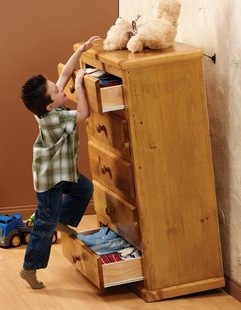 Top safety tips to help prevent tip-over hazards
Top safety tips to help prevent tip-over hazards
- If a piece of furniture is unstable or top-heavy, secure it to a stud in the wall using brackets, braces, anchors or wall straps. Large items such as TVs, microwaves, fish tanks, bookcases, heavy furniture and appliances can topple off stands and fall on children.
- If you have a newer, flat screen TV, make sure it’s properly anchored to the wall.
- Read the manufacturer’s instructions for tips or warnings regarding placement of your TV or furniture.
- Keep heavier items on lower shelves or in lower drawers.
- Don’t keep remote controls, candy, toys or other items that attract children on top of furniture, as your child might be enticed to reach for these items.
- Supervise young children at all times.

